Tell Tweini
Tell Tweini, sometimes known as Gibala, is a 12 hectare archaeological site located 1 kilometre east of the modern city of Jableh, Syria. It is situated within the coastal plain of Jableh, a short distance of two other main archaeological sites: Tell Sukas (5 km) and Tell Siyannu (6 km). As a tell, the site is the result of centuries of habitation on the same place, which resulted in a rising mound, as every new generation built their houses on top of the remains of older structures. The tell is sited about 1.7 kilometers from the coast but it appears that in the Bronze Age a sea incursion provided a harbor access to the sea. [1] [2]
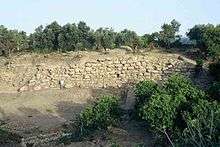 City wall of Tell Tweini | |
 Shown within Near East 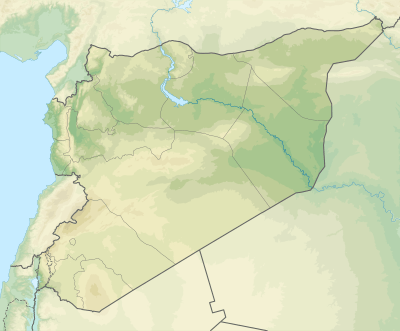 Tell Tweini (Syria) | |
| Alternative name | Gibala |
|---|---|
| Location | Latakia Governorate, Syria |
| Region | Levant |
| Coordinates | 35°22′18″N 35°56′11″E |
| Type | Settlement |
| Site notes | |
| Condition | In ruins |
History
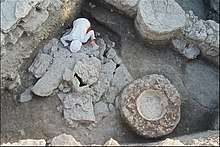
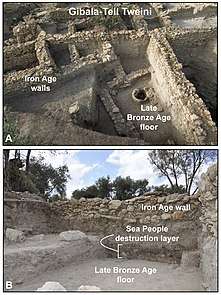
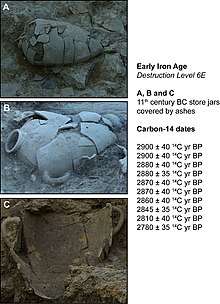
Tell Tweini was inhabited from at least the end of the third millennium BCE until the Persian period. The town may have been ancient Gibala, a city mentioned in a treaty found at Ugarit (modern Ras Shamra) from the 13th century BCE.
Middle Bronze Age
An extraordinary find at Tell Tweini was the communal tomb dating to ca 1700 BCE.
The grave contained the skeletons of 42 adults and 16 infants. Serving as grave-goods were 160 well-preserved ceramic vessels, plates and dishes, several bronze pins and a figurine. .. Among others, the grave goods included a fenestrated axe, quite typical for this period. Similar axes have also been discovered at Sukas, Ugarit and Byblos.[4]
Late Bronze Age
At the end of the Late Bronze Age Gibala formed the southern border of the Ugaritic kingdom. The transition between the Late Bronze Age and Iron Age remains one of the most poorly understood aspects of the most northern Levantine site, but preliminary results from the end of the 2007 campaign show that the city was inhabited during the 11th-10th century BCE. During the Iron Age, the city was completely urbanised. Geophysical prospecting conducted on the complete surface of the tell demonstrated this and made it possible to detect the ancient street system of the Iron Age city. By the Persian era the city had lost its importance and the habitation was relocated near to the modern harbour of Jebleh at the Mediterranean sea coast. Later, during the Byzantine domination of the region, some isolated structures were installed on the surface of the tell.
Archaeology
Since 1999, Tell Tweini has been investigated by a Syro-Belgian interdisciplinary team led by Michel al-Maqdissi, Joachim Bretschneider and Karel Van Lerberghe.[5]
Since excavations started in 1999, major discoveries include a Phoenician sanctuary, a large communal tomb from the end of the Middle Bronze Age containing 58 human remains, a large city wall, several domestic and public structures from the Iron Age I-II and multiple small finds. Excavations ended in 2010, interrupted by of local condition but work on the findings continue. [6]
Notes
- Bretschneider J, et al, The Late Bronze Age and Iron Age in the Jebleh region: a view from Tell Tweini. In: Kühne H, Czichon RM, Kreppner FJ, editors. Proceedings of the 4th International Congress of the Archaeology of the Ancient Near East. Wiesbaden: Harrassowitz Verlag, pp. 33–46, 2008
- Bretschneider, Joachim, Anne-Sophie Van Vyve, and Greta Jans., “Tell Tweini: a Multi-period Harbour Town at the Syrian Coast.” In Egypt and the Near East - the Crossroads, ed. J Mynarova, pp. 73–87, 2011
- Bretschneider, Joachim; Otto, Thierry (8 June 2011). "The Sea Peoples, from Cuneiform Tablets to Carbon Dating". PLOS ONE. 6 (6): 1–20. doi:10.1371/journal.pone.0020232. ISSN 1932-6203. PMC 3110627. PMID 21687714.
- The Syro-Belgian Excavations of Tell Tweini (PDF) telltweini.com
- Joachim Bretschneider and Karel Van Lerberghe, In search of Gibala. An Archaeological and Historical Study based on Eight Seasons of Excavations at Tell Tweini (Syria) in the A and C fields (1999-2007), Aula Orientalis Supplementa, vol. 24, 2008, ISBN 978-84-88810-79-3
- Bretschneider, Joachim, et al, “The Early Iron Age at Tell Tweini: Results from the 2008, 2009 and 2010.” In Tell Tuqan Excavations and Regional Perspectives : Cultural Developments in Inner Syria from the Early Bronze Age to the Persian/ Hellenistic Period, Proceedings, ed. Francesca Baffi, Roberto Fiorentino, and Luca Peyrone, pp. 325–342, CONGEDO EDITORE, 2014
See also
- Short chronology timeline - one of the chronologies of the Near Eastern Bronze and Early Iron Age
- Cities of the ancient Near East
References
- Bretschneider, J., Van Lerberghe, K. (2009). An Archaeological and Historical Study Based on Eight Seasons of Excavations at Tell Tweini (Syria) in the A and C Fields. The Syro-Belgian 'Tell Tweini' Project (1999–2007). In: In Search of Gibala. Barcelona: AUSA. Michel al-Maqdissi, Karel Van Lerberghe et al., The Occupation Levels of Tell Tweini and Their Historical Implications, in Proceedings of the 51st Rencontre Assyriologique Internationale, Oriental Institute SAOC 62, pp. 341–350, 2005
External links
| Wikimedia Commons has media related to Tell Tweini. |